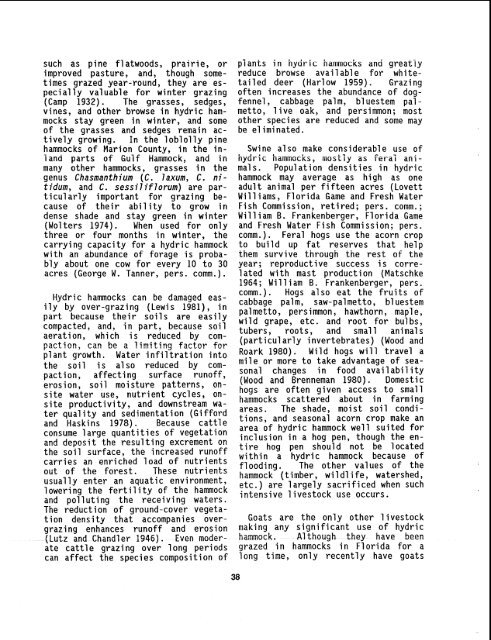a Guide to Management - USGS National Wetlands Research Center
a Guide to Management - USGS National Wetlands Research Center
a Guide to Management - USGS National Wetlands Research Center
You also want an ePaper? Increase the reach of your titles
YUMPU automatically turns print PDFs into web optimized ePapers that Google loves.
such as pine flatwoods, prairie, or<br />
improved pasture, and, though some-<br />
times grazed year-round, they are es-<br />
pecial ly valuable for winter grazing<br />
(Camp 1932). The grasses, sedges,<br />
vines, and other browse in hydric ham-<br />
mocks stay green in winter, and some<br />
of the grasses and sedges remain ac-<br />
tively growing. In the loblolly pine<br />
hammocks of Marion County, in the in-<br />
land parts of Gulf Hammock, and in<br />
many other hammocks, grasses in the<br />
genus Chasmanthiurn (C. laxurn, C. ni-<br />
tidum, and C. sessiliflorum) are par-<br />
ticularly important for grazing be-<br />
cause of their ability <strong>to</strong> grow in<br />
dense shade and stay green in winter<br />
(Wolters 1974). When used for only<br />
three or four months in winter, the<br />
carrying capacity for a hydric hammock<br />
with an abundance of forage is proba-<br />
bly about one cow for every 10 <strong>to</strong> 30<br />
acres (George W. Tanner, pers. comm.).<br />
Hydric hammocks can be damaged eas-<br />
ily by over-grazing (Lewis 1981), in<br />
part because their soils are easily<br />
compacted, and, in part, because soil<br />
aeration, which is reduced by com-<br />
paction, can be a limiting fac<strong>to</strong>r for<br />
plant growth. Water infiltration in<strong>to</strong><br />
the soil is also reduced by com-<br />
paction, affecting surface runoff,<br />
erosion, soil moisture patterns, on-<br />
site water use, nutrient cycles, on-<br />
site productivity, and downstream wa-<br />
ter qua1 ity and sedimentation (Gifford<br />
and Haskins 1978). Because cattle<br />
consume large quantities of vegetation<br />
and deposit the resulting excrement on<br />
the soil surface, the increased runoff<br />
carries an enriched load of nutrients<br />
out of the forest. These nutrients<br />
usually enter an aquatic environment,<br />
lowering the fertility of the hammock<br />
and ~ollutinq the receiving waters.<br />
plants in hydric hdn~rnocks and greatly<br />
reduce browse avai 1 able for white-<br />
tai 1 ed deer (Harl ow 1959) . Grazi ng<br />
often increases the abundance of dog-<br />
fennel, cabbage palm, bl uestem pal -<br />
met<strong>to</strong>, live oak, and persimmon; most<br />
other species are reduced and some may<br />
be el imi nated.<br />
Swine also make considerable use of<br />
hydric hammocks, rirosiiy as fera; ani-<br />
mal s. Popul at ion densities in hydric<br />
hammock may average as high as one<br />
adult animal per fifteen acres (Lovett<br />
Williams, Florida Game and Fresh Water<br />
Fish Commission, retired; pers. comm. ;<br />
William B. Frankenberger, Florida Game<br />
and Fresh Water Fish Commission; pers.<br />
comm.). Feral hogs use the acorn crop<br />
<strong>to</strong> build up fat reserves that help<br />
them survive through the rest of the<br />
year; reproductive success is corre-<br />
lated with mast production (Matschke<br />
1964; William B. Frankenberger, pers.<br />
comm.). Hogs also eat the-fruits of<br />
cabbage palm, saw-palmet<strong>to</strong>, bl uestem<br />
palmet<strong>to</strong>, persimmon, hawthorn, map1 e,<br />
wild grape, etc. and root for bulbs,<br />
tubers, roots, and small animals<br />
(particularly invertebrates) (Wood and<br />
Roark 1980). Wild hogs will travel a<br />
mile or more <strong>to</strong> take advantage of sea-<br />
sonal changes in food avail abi l i ty<br />
(Wood and Brenneman 1980). Domest i c<br />
hogs are often given access <strong>to</strong> small<br />
hammocks scattered about in farming<br />
areas. The shade, moist soil condi-<br />
tions, and seasonal acorn crop make an<br />
area of hydric hammock well suited for<br />
inclusion in a hog pen, though the en-<br />
tire hog pen should not be located<br />
within a hydric hammock because of<br />
flooding. The other values of the<br />
hammock (timber, wild1 ife, watershed,<br />
etc.) are largely sacrificed when such<br />
intensive lives<strong>to</strong>ck use occurs.<br />
The reduction of ground-cover vegeta-<br />
tion density that accompanies over- Goats are the only other lives<strong>to</strong>ck<br />
grazing enhances runoff and erosion making any significant use of hydric<br />
(Lutz and Chandler 1946). Even moder- hmmock. A1 though they have been<br />
ate cattle grazing over long periods grazed in hammocks in Florida for a<br />
can affect the species composition of long time, only recently have goats

















